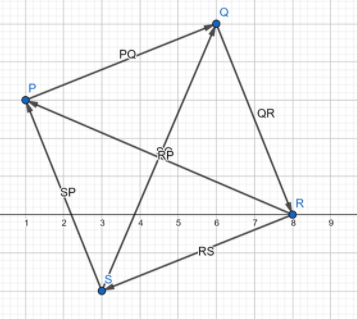
Find the midpoint of each diagonal of the quadrilateral with vertices $P(1,3)$, $Q(6,5)$, $R(8,0)$ and $S(3, - 2)$?
Answer
531.3k+ views
Hint: In the given question, we are required to find the midpoints of diagonals of a quadrilateral whose coordinates of vertices are given to us. The required task can be done using the midpoint formula where we find the midpoint of a line segment using a predefined formula. We just plug in the values of coordinates of vertices given to us to find out the midpoints of the diagonals.
Complete step by step solution:
Every quadrilateral has two diagonals. The quadrilateral PQRS has two diagonals PR and QS. The midpoints of these two diagonals can be calculated using the midpoint formula.

For the diagonal PR, coordinates of endpoint P are $(1,3)$ and that of R are $(8,0)$.
Using midpoint formula, Midpoint$ = \left( {\dfrac{{{x_1} + {x_2}}}{2},\dfrac{{{y_1} + {y_2}}}{2}} \right)$
So, Midpoint of diagonal PR is\[\left( {\dfrac{{1 + 8}}{2},\dfrac{{3 + 0}}{2}} \right) = \left( {\dfrac{9}{2},\dfrac{3}{2}} \right)\]
So, the midpoint of diagonal PR is \[\left( {\dfrac{9}{2},\dfrac{3}{2}} \right)\]
Similarly using midpoint formula,
We get the midpoint of diagonal QS as $\left( {\dfrac{{6 + 3}}{2},\dfrac{{5 + ( - 2)}}{2}} \right)$.
So, Midpoint of the diagonal QS is \[\left( {\dfrac{9}{2},\dfrac{3}{2}} \right)\].
Hence the midpoints of the diagonals of the quadrilateral PQRS whose coordinates of vertices are given to us are \[\left( {\dfrac{9}{2},\dfrac{3}{2}} \right)\] and \[\left( {\dfrac{9}{2},\dfrac{3}{2}} \right)\], So we conclude that the midpoint of both the diagonals is same as \[\left( {\dfrac{9}{2},\dfrac{3}{2}} \right)\]. Hence, the given quadrilateral is a parallelogram that has diagonals of a parallelogram bisecting each other.
Note:
We must remember the properties of each quadrilateral. The diagonals of a parallelogram bisect each other. Hence, the quadrilateral given to us in the question is a parallelogram and this can also be verified by calculating the sides of the quadrilateral and observing that the length of opposite sides are equal as well.
Complete step by step solution:
Every quadrilateral has two diagonals. The quadrilateral PQRS has two diagonals PR and QS. The midpoints of these two diagonals can be calculated using the midpoint formula.

For the diagonal PR, coordinates of endpoint P are $(1,3)$ and that of R are $(8,0)$.
Using midpoint formula, Midpoint$ = \left( {\dfrac{{{x_1} + {x_2}}}{2},\dfrac{{{y_1} + {y_2}}}{2}} \right)$
So, Midpoint of diagonal PR is\[\left( {\dfrac{{1 + 8}}{2},\dfrac{{3 + 0}}{2}} \right) = \left( {\dfrac{9}{2},\dfrac{3}{2}} \right)\]
So, the midpoint of diagonal PR is \[\left( {\dfrac{9}{2},\dfrac{3}{2}} \right)\]
Similarly using midpoint formula,
We get the midpoint of diagonal QS as $\left( {\dfrac{{6 + 3}}{2},\dfrac{{5 + ( - 2)}}{2}} \right)$.
So, Midpoint of the diagonal QS is \[\left( {\dfrac{9}{2},\dfrac{3}{2}} \right)\].
Hence the midpoints of the diagonals of the quadrilateral PQRS whose coordinates of vertices are given to us are \[\left( {\dfrac{9}{2},\dfrac{3}{2}} \right)\] and \[\left( {\dfrac{9}{2},\dfrac{3}{2}} \right)\], So we conclude that the midpoint of both the diagonals is same as \[\left( {\dfrac{9}{2},\dfrac{3}{2}} \right)\]. Hence, the given quadrilateral is a parallelogram that has diagonals of a parallelogram bisecting each other.
Note:
We must remember the properties of each quadrilateral. The diagonals of a parallelogram bisect each other. Hence, the quadrilateral given to us in the question is a parallelogram and this can also be verified by calculating the sides of the quadrilateral and observing that the length of opposite sides are equal as well.
Recently Updated Pages
Master Class 10 General Knowledge: Engaging Questions & Answers for Success

Master Class 10 Science: Engaging Questions & Answers for Success

Master Class 10 Social Science: Engaging Questions & Answers for Success

Master Class 10 Maths: Engaging Questions & Answers for Success

Master Class 10 English: Engaging Questions & Answers for Success

Master Class 10 Computer Science: Engaging Questions & Answers for Success

Trending doubts
Which places in India experience sunrise first and class 9 social science CBSE

Fill the blanks with the suitable prepositions 1 The class 9 english CBSE

Write the 6 fundamental rights of India and explain in detail

Difference Between Plant Cell and Animal Cell

What is the Full Form of ISI and RAW

Golden Revolution is related to AFood production BOil class 9 social science CBSE




